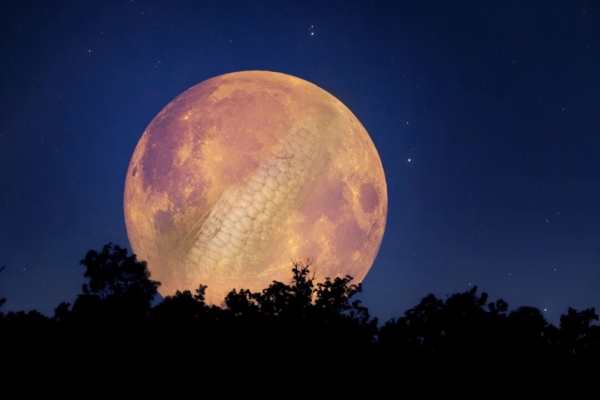This September, the moon is set to appear larger than usual – even by Harvest Moon standards. In this season, the sweet-scented leaves turning yellow and the yellow school buses rumbling, the slightly cool air tells us: autumn has arrived.
Approaching the autumn equinox, the full moon in September 2024 has a special name: Harvest Moon.
On September 17, the full moon will arrive closer to Earth than usual, making it a supermoon, appearing significantly larger.
In the Eastern United States at 10:34 p.m., you will see the Harvest Moon rising to the east as the sun sets in the west. The full moon always faces the sun, giving it a round and large appearance due to direct sunlight.
Historically, the Harvest Moon is known for its faint, ultra-low, and yellowish appearance in the night sky. It seems to exist longer and larger like a traditional lantern with a centuries-old history, helping farmers complete their final harvest before frosts and winter set in as daylight shortens.
However, some say this enlarged appearance is merely an illusion. Why is that?
Astronomers from NASA say the apparent enlargement effect of the Harvest Moon is related to the horizon. Because the period close to the vernal equinox is when the moon’s ecliptic plane tends towards the horizon, people in autumn see the moon in this position, creating the illusion of enlargement.
Usually, the Harvest Moon is not larger than June’s Strawberry Moon or any regular full moon. But when the full moon is low, aligned with buildings, hills, and trees, it creates an illusion. However, this is just psychological. Objects on land appear smaller, while the moon seems larger. This visual misinterpretation creates the term “moon illusion,” a phenomenon that often occurs in autumn.
But this September’s Harvest Moon will indeed appear larger. Why is that?
Because it will be a supermoon.
The moon only truly enlarges three to four times a year. This is not just an illusion. During these times, the full moon appears 7% larger, becoming a supermoon. This phenomenon occurs because the moon’s orbit is not a perfect circle but rather elliptical. Therefore, at certain times, it is closer to the Earth, sometimes farther away; its closest point is called the “perigee,” and the farthest point is called the “apogee.” When in alignment with the perigee – strictly speaking, the full moon landing there is astronomically unlikely but can be very close – the full moon is referred to as a supermoon.
Hence, the next Harvest Moon occurring on September 17 is termed a supermoon. Just a day after the full moon sets, on September 18, it will reach the perigee, further magnifying the already impressive moon illusion. This enlarged appearance will last for several days.
But that’s not the whole story behind the Harvest Moon. For millennia, ancient farmers noticed a strange phenomenon: the low-hanging Harvest Moon seems to rise oddly early – mysteriously appearing before expected, providing light after dusk in the ever-shortening daylight to aid farmers in harvesting their fields.
This is not an illusion either. While on average, the moon rises 50 minutes later each night throughout the month as it traverses its eastward orbit (thus creating the lunar cycle), its rise time around the autumnal equinox only delays by 23 minutes. It seems that the heavens provide a boon for corn-harvesting farmers (hence the name Harvest Moon and another name for the September full moon: Corn Moon).
Scientists attempt to explain this moon slowdown. The Farmer’s Almanac simply explains that the autumnal equinox marks when the moon’s arc has its greatest northerly extent, hence being the longest. Therefore, after the equinox, as the moon rapidly moves north each night, it also seems to rise earlier than expected. The farther north one goes, the more pronounced the moon’s anomaly becomes.
Normally, the September full moon is named Corn Moon, not Harvest Moon. As mentioned earlier, this is because farmers harvest corn crops during that month. However, the names Harvest Moon and Corn Moon interchange between September and October.
The October full moon is called Hunter’s Moon. However, the autumn equinox is a special event, with only the full moon closest to it being named the Harvest Moon. The equinox sometimes falls in September, other times in October. So, while Corn Moon and Hunter’s Moon refer to the entire lunar cycle, Harvest Moon is a name suited solely for the full moon event.
The original article, “‘1000 Hours Outside’: Mom of 5 Starts Global Movement to Get Kids Outdoors and Reclaim Childhood,” was published in English on the Epoch Times website.

